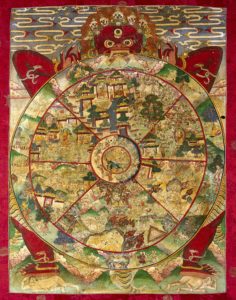Siddartha Guatama, who had come to be known as Buddha, passed on many spiritual teachings that have survived hundreds of years and have lent themselves to much discussion and in-depth analysis and explanation. In particular, one will find many references to “suffering” associated with the human condition.
Buddha recognized that all existence is suffering due to our feelings of attachment to people and objects as well as our delusions about existence and impermanence. But he set out spiritual and intellectual guidelines that would bring one out of a state of suffering through spiritual awareness and right behavior that eventually frees an individual from attachments and suffering. These guidelines are known as the “Eightfold Path”.
In order to understand the Eightfold Path, one must have a knowledge of the Four Noble Truths which actually can be said to encapsulate all of the Buddha’s teachings. These are often interpreted at great length but following a simplified version.
The Four Noble Truths ~
1 ~ existence is suffering due, in part, to our inability to accept that all existence is impermanent. By accepting that all things change, one can let go of attachments that only serve to make one unhappy.
2 ~ suffering has a cause namely craving, or thirst, for things physical, sensual, emotional. Desires ensure we will never be satisfied.
3 ~ suffering can end through mastering non-attachment.
3 ~ in order to end suffering one must follow the Eightfold Path.
So we see in this sense that the Eightfold Path is a prescription to end suffering. It is a series of “right” actions.
The Noble Eightfold Path
The Right View ~ involves accepting the truth of the Four Noble Truths and seeing existence as it really is. It means understanding the impermanence of existence as well as the laws of Karma.
The Right Intention ~ involves a commitment to self-improvement and can be broken down into three intentions: the resistance to the craving, the intention of goodwill to others and the intention of harmlessness.
The Right Speech ~ is the first on the path that involves deliberate action as opposed to thought. The principles of the right speech are simple: do not lie or speak deceitfully; do not hurt others through malicious talk about them;. Do not speak offensively or harshly to others; do not engage in meaningless talk that lacks purpose.
 The Right Action ~ includes several activities that should never be engaged in: physical harm or killing of oneself or other beings; do not steal; do not engage in sexual misconduct; respect other persons and their property; act kindly.
The Right Action ~ includes several activities that should never be engaged in: physical harm or killing of oneself or other beings; do not steal; do not engage in sexual misconduct; respect other persons and their property; act kindly.
The Right Livelihood ~ demands that we earn a living in a way that brings no harm to others, including animals. As in the past, today that would include not dealing in weapons, slave-trade, animal slaughter, intoxicants,. or poisons. In our livelihoods, we would also avoid harm through stealing, lying, sexual misconduct and other precepts aforementioned.
The Right Effort ~ requires us to channel our mental energy and action into wholesome endeavors and thoughts that will assure we stay on the eightfold path. This is closely linked with Karma and has four aspects: the effort to “avoid”, an effort to “overcome”; effort to “develop” ; effort to “maintain. “. These basically mean to avoid and overcome undesirable inner conditions and develop and maintain meritorious ones.
The Right Mindfulness ~ requires deliberate contemplation on our own thoughts in order to achieve a purer perception of reality not muddied by other influences. One might today call it “mega-cognition” but it requires us to be contemplative of our bodies, our emotional reactions, and our mood. If we remain aware of our mind, we can better achieve other requirements on the path to end our suffering.
The Right Concentration ~ can be considered a way to focus our attention and thoughts on our path and wholesome thoughts and is accomplished best through meditation practices.
It would be in one’s interest to understand Karma as well as Buddha’s precepts and Four Noble Truths if one is to embark on life following the Eightfold Path. And while there are countless sources of explanatory and expository writings about Buddhist teachings, it is wise to start with those sources that explain things in terms one can understand, rather than in advanced spiritual terms. A good place to begin one’s understanding is with Buddha’s concept of impermanence.





